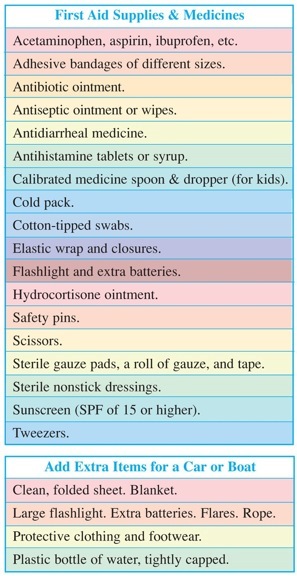Emergency Procedures


-
Emergencies & First Aid
Introduction
The focus of this section is to help you learn:
-
•When a problem needs emergency medical care.
-
•What to do before getting emergency care.
-
•When and how to give first aid.
Chapter 21 gives brief guidelines for CPR and first aid for choking. These do not take the place of formal training for these life-saving measures.
Chapter 22 helps you decide what to do for medical emergencies and what first aid measures to give for many health conditions.
Emergency Conditions / First Aid
Recognizing Emergencies
What Is a Medical Emergency?
A medical emergency means death or serious harm could result without prompt care. Warning signs of a medical emergency include:
-
•Any stroke warning sign.
-
•A hard time breathing or shortness of breath. Not being able to say 4 or 5 words between breaths.
-
•Fainting. Loss of consciousness.
-
•Change in mental status, such as unusual behavior or confusion.
-
•Sudden, severe pain anywhere in the body.
-
•Bleeding that won’t stop.
-
•Vomiting that is severe or that persists.
-
•Coughing up or vomiting blood.
-
•Suicide attempts or gestures. Making plans for suicide. Repeated thoughts of suicide.

Being Ready for Medical Emergencies
-
•Learn basic first-aid skills. Take courses in PR and first aid. These give hands-on practice in giving first aid and CPR the right way. Find out about them from your local Red Cross, police and/or fire department, etc.
-
•Find out what services your health plan covers and what steps you have to take to get emergency costs paid for.
-
•Carry the following information with you at all times:
-
-Your name, address, phone number, and the person to contact if you need emergency care.
-
-Your health insurance information.
-
-Important medical information. This could be on a medical alert tag, on a wallet card, or on the back of your driver’s license. Have a list of medications, their dosages, and things you are allergic to.
-
-Emergency telephone numbers. (Post these near phones, too.)
-
•Read Chapters 21 and 22 to learn what to do for conditions that need emergency medical care and/or first aid.
First-Aid Kit
Keep first-aid supplies handy, but out of children’s reach. Carry a first-aid kit in the car (or boat, wrapped in a waterproof container), as well as in the house. Campers, bikers, hikers, and persons who spend time in remote areas should take a first-aid kit with them. Once a year, check supplies for expiration dates. Restock items when they are used up or when expiration dates have passed. {Note: See also Be Prepared for Disasters & Threats.}
Ask your doctor if you should get emergency care for symptoms other than the ones listed here.






Copyright © 2009, American Institute for Preventive Medicine. All rights reserved.
